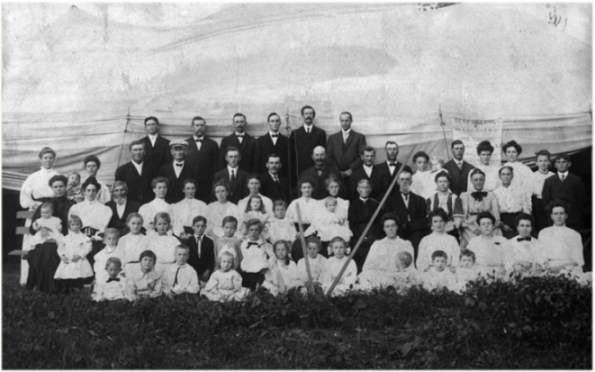Alfred Ellmore
August 11, 1838 - December 11, 1925
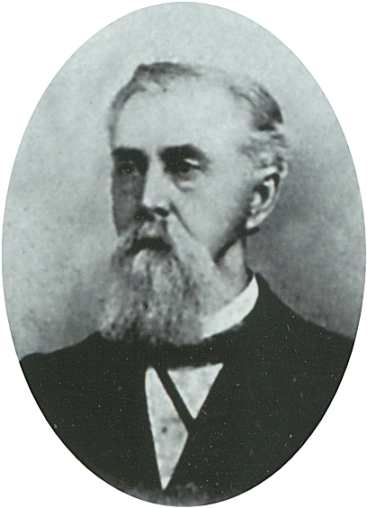
Biographical Sketch On The Life Of Alfred
Ellmore
Excerpt From Search For The Ancient Order Volume 1
Indiana produced its share of good preachers. There was Horace Hinds, godly, unassuming, and thoroughly dedicated to Christ.(23) There was Thad Hutson, whom J. C. Meyers described as a "pious, unassuming young man, resembling President Lincoln very much."(24) There was E. C. Denny, "the giant killer of southern Indiana," and Frank and Will Ellmore. None, however, exceeded Alfred Ellmore in length of ministry and powerful impact.
Few men have ever loved their chosen life as much as Ellmore loved his, in spite of the hardships connected with it. He always wanted to be a preacher from his earliest days and when one arose to speak, Ellmore, as a young lad, could hardly "contain himself." Born August 11, 1838, near Owl Prairie in southern Indiana, he saw his first light of day in a log cabin, the eighth of ten children. He attended the neighborhood log-cabin school where he seldom saw a blackboard or a grammar book but did see numerous switches. His parents were born into the Quaker faith, but in the quest for divine truth they became New Light Baptists until they heard the full gospel. Few men in the Indiana wilderness knew the Bible like Eleazor, Alfred's father.
Alfred seemed destined to be a preacher. When he was grown, his older brother said to him, "Owing to blood and the influence upon our mother, made by preaching of the gospel by the most powerful preachers of that day, just prior to your birth, you were born a preacher." Alfred added, "Owing to my father's prayers." A strange feeling swept Alfred as a boy when he heard the story of a dream by a devout Methodist woman on the street in the small town where they lived. She dreamed that the Savior came to Eleazor Ellmore and said, "I want one of your boys to go and preach." In the fantasy Alfred had replied, "My two brothers are gone from home, and I am here alone with my parents." At that point in the dream Alfred's mother had spoken up, "Alfred, if the Savior wants you to go preach, go. Father and I will get along somehow." Finally, in the dream, Alfred had put on his hat and went with his Savior (25 )Whether Alfred as a youth viewed this fantasy as an omen is difficult to say. However, he knew as others did, that someday he would be a preacher.
The Civil War was grinding to a close when Alfred went to an Academy five miles south of Frankfort, Indiana, and made his first effort to speak. It was the third Sunday of March 1865 when the twenty-seven years old Alfred stood up "with fear and trembling" to address people whom he had known from his birth.(26) He had been baptized eight years before, and years later, regretted that he had not started this earlier:
I have no desire to live again in this world only that I might do more good than I have done. Instead of being immersed at nineteen, I would go into the church at fifteen, and instead of waiting until twenty-seven, I would enter the ministry at twenty, and I would preach, yes sir. If I were the son of a rich man, I would preach. If I were the son of a poor man I would preach. If too poor to make a living, and the brethren did not support me, I would work on the bench, in the field, in the garden, in the school room, and then preach as I had opportunity. I might keep some cows and some chickens, but I would preach the gospel. If I were in age and became a bishop, I would go out during the week into destitute places and preach the gospel... for forty three years I have been a busy man . . . and I am still able and willing and anxious to preach the gospel of Christ.(27)
Ellmore's childhood home life, though materially sub-standard, was spiritually idyllic, and it contributed greatly to his insatiable desire for the ministry. "Though my childhood home was very humble," he once wrote, "yet if I could have my parents and my brothers and sisters return, I would prefer that home to the finest mansions with the most costly furnishings. Our diet was plain but sumptuous, our apparel was something patched and in a house rude and open, in winter we sometimes almost suffered, but O, the tender love . . . "(28) Years later, after explaining this boyhood desire, Ellmore wrote,
And having walked under the burning sunshine for half a century, I find that my springtime is passing away, and my summer is ended, and the world has few charms for me. My whole life has been one of toil, the few sweets from the well of salvation have been sufficient to keep my spirit refreshed, while the adverse winds have not ceased to blow which 1 suppose have been a help rather than a hindrance to me . . . (29)
He explained that he could truly say, "the Lord is my Shepherd." He had learned to care little what others had said against him, "and were it not for the hope of benefiting our poor humanity, I sometimes think I would like to enter some quiet vale and there spend my time unto the winter of death . . ."
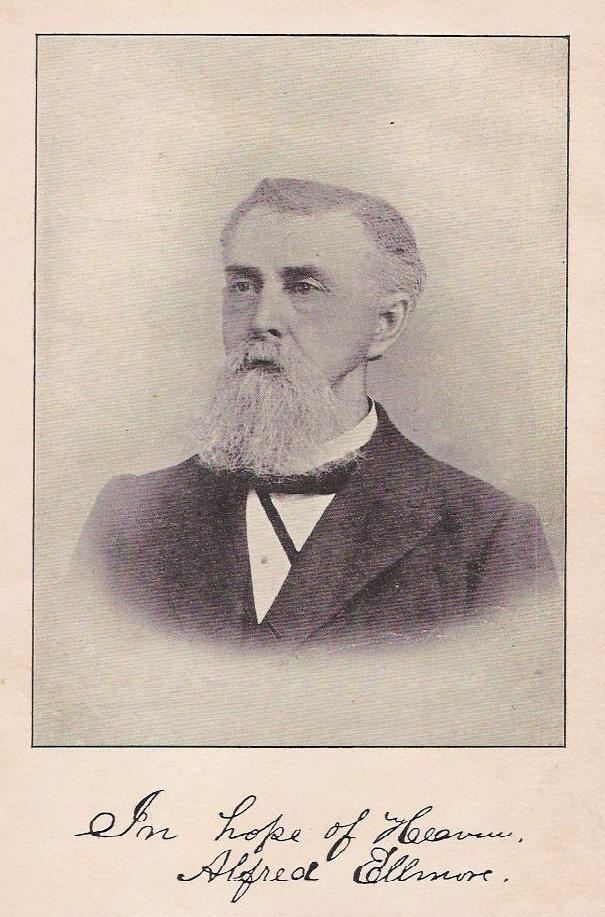 As a
young minister, Ellmore loved all preachers almost to veneration. His favorite
was Ben Franklin, editor of the American Christian Review. When a young
man, Ellmore spent three hours with Franklin in a restaurant in Indianapolis.
When they separated, Franklin took his hand and said, "Brother Ellmore, do
all the good you can and no harm." Ellmore said later, "That
admonition went through me like a dart. (30) As the years passed, he
noted that older preachers were not given large audiences, and that Franklin
lost his popularity and was called only to speak in rural districts and to small
audiences.(31)
As a
young minister, Ellmore loved all preachers almost to veneration. His favorite
was Ben Franklin, editor of the American Christian Review. When a young
man, Ellmore spent three hours with Franklin in a restaurant in Indianapolis.
When they separated, Franklin took his hand and said, "Brother Ellmore, do
all the good you can and no harm." Ellmore said later, "That
admonition went through me like a dart. (30) As the years passed, he
noted that older preachers were not given large audiences, and that Franklin
lost his popularity and was called only to speak in rural districts and to small
audiences.(31)
Few preachers ever gave to their work more tireless devotion than Ellmore. In 1901, he turned his paper, the Gospel Echo, over to the Gospel Advocate and began a column called "Silver Chimes." He mused that he had been in the ministry thirty-six and one-half years and that during these times he had preached three times every Sunday, and often four. Though he was now past sixty-three years of age, he still averaged speaking fourteen times a week and carried a heavy correspondence for the papers, yet he was seldom overly-tired. "I have reduced my work to a system and find plenty of time for it all. I am often asked why I make such efforts, and my reply usually is: `I believe the Bible statements regarding rewards and punishment in the future for actions in this life, and I shall not return here to correct mistakes or to put in one hour of misspent time.’”(32) That spring he traveled to Oklahoma Territory where S. W. York heard him and remarked,
.. . I have never known a man of stronger faith or more untiring zeal in the cause of the Master. His presentations of the gospel in his sermons are always plain and forcible, and his love for the truth causes him to go among all classes, from those who dwell in the humble cottage to the inhabitants of lofty mansion, carrying the unsearchable riches of Christ.(33)
When Ellmore's book, Sermons and Reminiscences was published in 1914, W. J. Brown took a special interest since he had heard Ellmore deliver the first sermon in the book in Belmont, Illinois, in 1892. Brown reflected nostalgically, "he presents the gospel facts in a way that is simple, striking, true and mostly original and interesting . . . I believe it will do much good in showing the people the plain way of salvation, and extend his influence for good, long after his work for the Master is done.”(34)
Ellmore found little ease in his chosen field of labor. "For forty-five years," he once said, "I have been a teacher in the field, and no days were too cold, no nights too dark, roads never too bad for me to go if any other man could go. And while on some occasions I have been liberally rewarded, on many I have labored for twenty-five, ten or fifteen cents per day and for hundreds of days I have not received a penny a day. I am now two hundred miles from home preaching in a sectarian house, and there is not one member in the neighborhood and but one man to look to for aid, and it is desired that we continue indefinitely."(35 )Earlier, he had written:
The winter was bitter cold–too severe to be successful. It was not a pleasant duty for a man of 66 to travel in sleet, mud, and ice, warm up cold beds, eat irregularly and often such diet as does not suit the digestion of one already injured by such viands, etc. But the worst feature of all is, the churches are almost dead–some entirely lost in the weeds–and, of course; there is very little reward, earthly, among such people. For twenty years I have been urging the people to establish the worship and press every able man and woman to be present and do their duty every first day and support faithful men and send them into the wilderness to preach the gospel to the lost . . .36
In working out his own private philosophy of life Ellmore sought Christian magnanimity; he would thus avoid personal pettiness. "It is a thousand times better that we pass an insult by than to resent it," he once said. "If we stop to quarrel, we make a greater enemy of him who would injure us and becloud our own pathway, whereas, if we pass the enemy unnoticed, he may become ashamed and confess his wrong. Let us do good for evil. No man is yet a perfect Christian, who will not do this."" Whether in personal relations or in public speaking he placed the highest emphasis upon love. "After having preached for more than fifty years, and to almost every grade and class of society, I am now fully convinced that one great element in order to success is kindness. Shall we undertake to reform the drunkard by tearing down his house? Let us be firm, but very kind.”(38)
As age approached, Ellmore sought to extend his labors into the warmer climate of Texas. In March 1907 he went to Gunter for an evangelistic effort and met N. L. Clark and "learned of the true greatness of the man," he explained.(39) He returned early the next year to spend five months with the Gunter Bible College during which time he was ill with a severe affliction. Now, he began to shuttle back and forth between Texas and his home in Covington, Indiana.
In January 1911 he came to work in Austin where he labored with the church in the eastern part of the city and often in tent meetings. After preaching to a large body of university students late in January on "The Church-Origin, Organization and Work," Showalter wrote, "Brother Ellmore is a preacher, in my judgment, worthy of the work. "(40) He returned to Covington in the spring and then back to Austin in September where, when the train arrived, almost the whole church was waiting for him. He noted the change of weather from Indiana where it was "damp and pleasant" to Texas where it was "very dry and hot-almost beyond endurance."(42) Resuming his work in the Southwest, Showalter noted, "Brother Ellmore is loved and appreciated by the whole church. In most large cities not one in one hundred bear the gospel in its primitive simplicity. Austin is trying to change this,"(42) By early 1912 J. D. Tant visited Austin and found "old brother" Ellmore, he said, hard at work preaching from house to house and delivering five to six sermons per week. "If reports be true," Tant added, "Brother Ellmore is one of the best personal workers in the church of Christ today."(43) In the summer of 1912 he was back in Covington where T. J. Jackson saw him after several years and "studied with delight the young spirit encased in the aged body . . ." Ellmore remarked to Jackson that he lived on a beautiful street and Jackson placed his hand on his shoulder and said, "yes, brother, it is a very nice street, but there is one more beautiful awaiting us over there. "(44) There was, however, no rest yet, for a year later, he returned to Texas where he replaced Clark as president of Gunter Bible College.
(23)Earl West, “Horace Hinds: Glorious In Obscurity,” Gospel Advocate, CIV (Apr. 19, 1962), 248,9
(24)J.C. Myers, "Briefs Here And There,” Christian Leader, XIV (July 24, 1900), 4.
(25)G.H.P. Showalter, "Alfred Ellmore," Firm Foundation XXVIII (Mar. 26, 1912), 2.
(26)Alfred Ellmore, “Wheat and Chaff,” Christian Leader, XXVIII (Apr. 20, 1915), 1.
(27)Alfred Ellmore, “Wheat and Chaff,” Firm Foundation, XXIV (Sept. 1, 1908), 4.
(28)Alfred Ellmore, “Wheat and Chaff,” Firm Foundation, XXX (Aug. 18, 1914), 1.
(29)Alfred Ellmore, “Wheat and Chaff,” Firm Foundation, XXVII (Oct. 10, 1911, 1
(30)Alfred Ellmore, “Wheat and Chaff,” Firm Foundation, XXIX (Oct. 21, 1913), 1.
(31)Alfred Ellmore, “Notes,: Gospel Advocate, XLIV (Jul 10, 1902), 443.
(32)Alfred Ellmore, “Silver Chimes,” Gospel Advocate, XLIII (Oct. 24, 1901), 683.
(33)S.W. York, “Oklahoma Territory,” Gospel Advocate, XLIII (Apr. 11, 1901), 237.
(34)W.J. Brown, “Items Of Passing Interest,” Christian Leader, XXIX (Feb. 23, 1915), 4.
(35)Alfred Ellmore, “Wheat and Chaff,” Firm Foundation, XXV (Nov. 9, 1909), 1.
(36)Alfred Ellmore, “Wheat and Chaff,” Firm Foundation, XXI, (Apr. 11, 1905), 6.
(37)Alfred Ellmore, “Wheat and Chaff,” Firm Foundation, XXVII (July 11, 1911), 7.
(38)Alfred Ellmore, “Wheat and Chaff,” Christian Leader And The Way, XX (Feb. 13, 1906), 4.
(39)Alfred Ellmore, “Wheat and Chaff,” Firm Foundation, XXVII (Mar. 7, 1911), 1.
(40)G.H.P. Showalter, “Austin Brethren,” Firm Foundation, XXVII (Feb. 7, 1911), 2.
(41)Alfred Ellmore, “Wheat and Chaff,” Firm Foundation, XXVII (Oct. 3, 1911), 1.
(42)G.H.P. Showalter, “Austin Is Helping Herself,” Firm Foundation, XXVII (Dec. 5, 1911), 2.
(43)J.D.Tant, “The Church of Christ At Austin, Texas,” Firm Foundation, XXVIII (Jan. 16, 1912), 5.
(44)News & Notes, “The Cincinnati Mission,” Gospel Advocate, L (May 14, 1908), 315.
–The Search For The Ancient Order, Volume III, Earl Irvin West, Religious Book Service, Indianapolis, Indiana, pages 192-196
Note: The information above is an excerpt from a volume of one of the foremost historians among the Restoration Movement, Earl I. West. In Volume III of the series, Search For The Ancient Order, the events surrounding the turn of the 20th century are discussed in depth. This excerpt is reproduced above with his footnotes that appear here as endnotes, the numbers being as they appeared in the book. For further information on other people and events in the R.M., this series is a must for the serious student of the Restoration History. Special thanks is extended to Terry J. Gardner of Indianapolis, Indiana for supplying information of the final resting place of Alfred Ellmore.
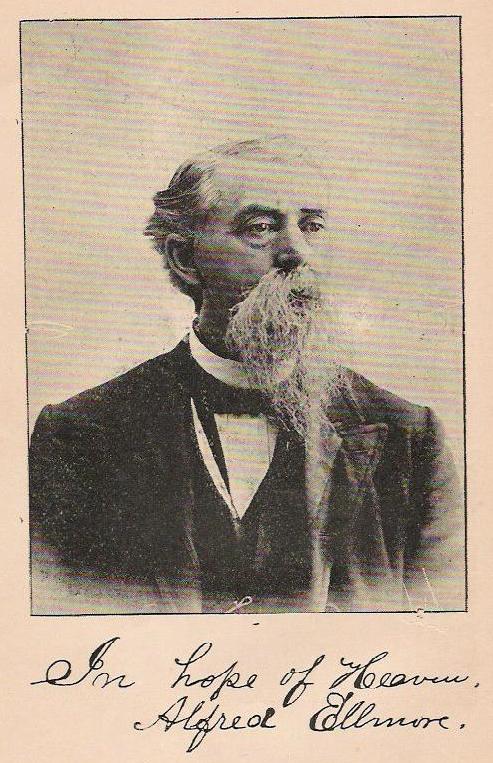
See Another Sketch On Alfred Ellmore Here
![]()
GOD'S NOBLEMEN
By Alfred Ellmore
Composed March, 1881
The greatest, noblest men of earth,
Since Peter, John, and Paul,
Are not the men of noble birth,
Such as the world would call;
Not those of military fame,
Who've slain their thousand-fold—
But those who wear a greater name
Than kings, who're crowned with gold.
We've heard such blow the trump of God,
While standing 'neath the trees,
Where many felt the chastening rod,
And fell upon their knees.
We've heard the message with such power,
It seemed the rocks would cry;
And wished the world in one short hour,
Might hear it ere they die.
These noble men are "going away”!
Such news historians tell;
They say we'll meet some future day,
But oh, this sad farewell.
Such men as Campbell, Stone and Scott,
And Smith, and Green, and Creath,
Oh, fairy poets, tell me not
That such go down in death.
And Franklin, Rogers, Wright and Brown,
J. Wolf and John O'Kane,
You tell me such are going down?
This fills my heart with pain.
And where are Lockhart, Hopkins, Raines,
And Johnson, Emmons, Burns?
You tell me they are bound in chains?
Oh, save the heart which mourns.
It seems such men should here remain,
While sin and sloth are found;
Until the enemy is slain,
And peace and love abound.
How loth are we to give such up,
Who've been our constant guide;
How hard to drink this bitter cup,
And say that such have died!
They told us of a happier clime,
Unstained by Adam's sin;
Where life is measured not by time,
Nor death can enter in.
Now, since before us these have gone,
And beckon us away,
Why should we dread to follow on,
And meet in endless day?
contributed by Terry J. Gardner, July, 2012
![]()
Covington Minister Called To Reward
_________
Spent Many Years Preaching the Gospel in Many DIfferent States
Rev. Alfred Elmore, 87, one of the best known ministers and evangelists in the middle west, died at his home here early Friday, from the infirmities of age and the effects of a fall about a week ago, when he suffered a broken hip.
He was born at Frankfort Aug. 11, 1838 and was a minister of the Church of Christ for approximately sixty years. He had resided in Covington for thirty years, during which time he held many pastorates and held revival services in nearly every state in the union. He at one time held considerable property in and about Covington, most of it being converted into cash before his death.
He was united in marriage to Elizabeth Bogan, Nov. 7, 1859. She died here Nov. 5, 1906 and on August 18, 1907, he was united in marriage to Martha Brown, of Texas, who survives. Surviving also are Will and Frank, of Covington and Mrs. Della Elston, of Louisiana.
Funeral services were held at the Seventh street Church of Christ Sunday afternoon at 2:30 o'clock in charge of Rev. M.J. Elston, a son-in-law. Burial in Mt. Hope cemetery.
-Covington Republican, Vol. LI, No. 2 (18 December 1925): 1.; Special thanks to Terry J. Gardner for making this news item available.
![]()
Obituary
__________
Rev. A. Ellmore
Alfred Ellmore was born near Frankfort, Indiana, on Aug. 11 1838; died at his home in Covington, Indiana Dec. 11, 1925. He was the son of Eleazar and Ratchel Elliott Ellmore, being the eighth child of a family of ten children.
He grew up under very strict religious training, his father being a religious teacher in his family, and the theme of his instruction was the work and worship of the Lord as taught and practiced by Christians and churches in New Testament times.
A very common saying with his father was: "My son, let the New Testament settle every question of religious faith and practice with you," and to this we all know he strenuously adhered to the last. He obeyed the gospel at the age of nineteen years, and soon after began to take part in the public worship of the church.
He was an excellent singer, and from leading the song service, he soon began to pray and exhort in public. He began his ministerial work on the second Sunday in March, 1865, taking for his theme at that time, "The Unity of Christians," and to this end he worked until God called him home.
His labors were widely known, having preached from coast to coast and from the Gulf of Mexico to Georgian bay, also on board ship on the Atlantic ocean, his converts numbering over 8,000.
He published a number of books and tracts on religious subjects, and was, for several years, editor of "The Echo," a religious journal published at Covington, Indiana. He was also, for ten years, president of Gunter Bible college, at Gunter, Texas.
On Nov. 17, 1859 the subject of this sketch was united in marriage to Elizabeth Bogan, who died Nov. 5, 1906. Seven children were born of this union: Austin, Della (now the wife of B.J. Elston) William, Frank, Anna (who, at the time of her death was Mrs. Josiah Laney) Olive and Bert J. Ellmore. Austin, Anna, Olive and Bert have all passed to the other side.
Mr. Ellmore was married the second time on August 18, 1907, to Mrs. Mattie A. Brown of Salem, Indiana, who, for the past eighteen years, has been his helper, sharing his joys and sorrows, cheering him in shadow and sunshine and caring for hime, as no other could have done, to the end.
He leaves besides the faithful wife, two sons, William and Frank both of Covington, one daughter, Mrs. Elston of Carson, La., fifteen grandchildren and five great-grand-children, also many other relatives and numberless friends. "Blessed" are the dead who die in the Lord."
-Covington Republican, Vol. LI, No. 2 (18 December 1925): 3. Special thanks to Terry J. Gardner for making this news item available.
![]()
Directions To Grave
Mt. Hope Cemetery
Section A-Lot 15-Grave 2
Actual GPS Location Of The Grave
40°07'40.2"N 87°23'12.9"W
or D.d. 40.127845, -87.386912
Grave Faces West
From Indianapolis, Indiana you take Interstate 74 to the west. It is about a one hour drive. You take the Covington exit (exit #8 which also means it is eight miles from the Indiana - Illinois border. Turn right (north) as you exit the interstate onto South Meridian Avenue. The Mt. Hope cemetery is about two miles north of the interstate and is on both sides of the road. Alfred Ellmore is buried on the west side of the road (to a drivers left as he is heading north toward Covington). Enter the south entrance and wind around to the south-west corner of the cemetery. Stop the car and look notice that Ellmore's grave is in the sw corner of the cemetery. When searching for his son, William's grave, remember it is on the same side of the road, but at the north end. See his page and directions here.
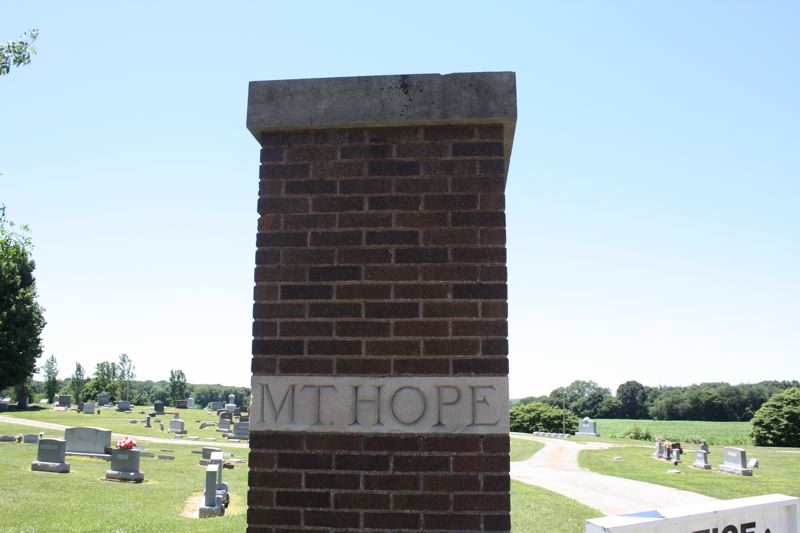
North Entrance Of Mt. Hope Cemetery - Best To Enter SOUTH Entrance
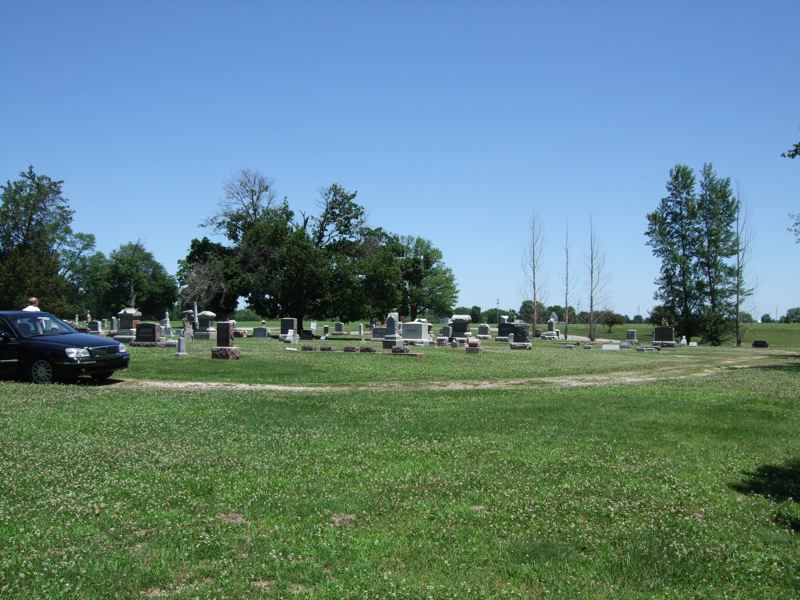
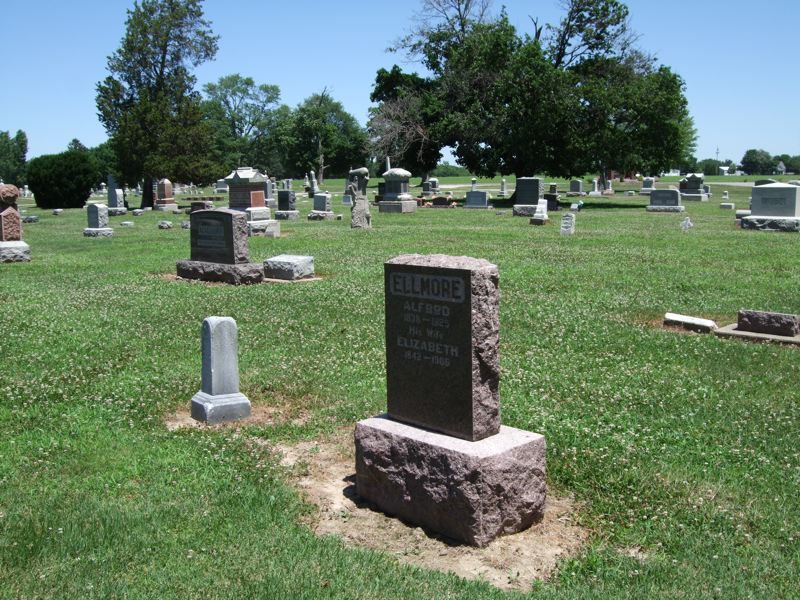
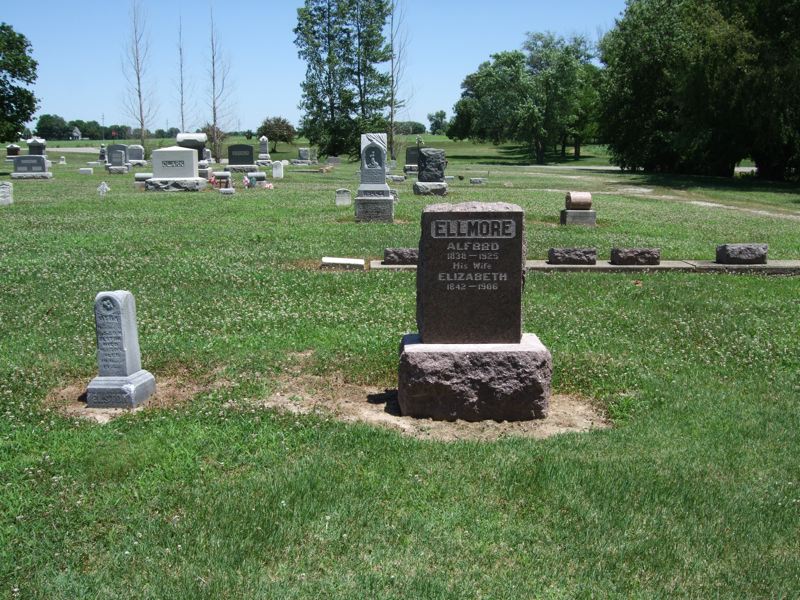
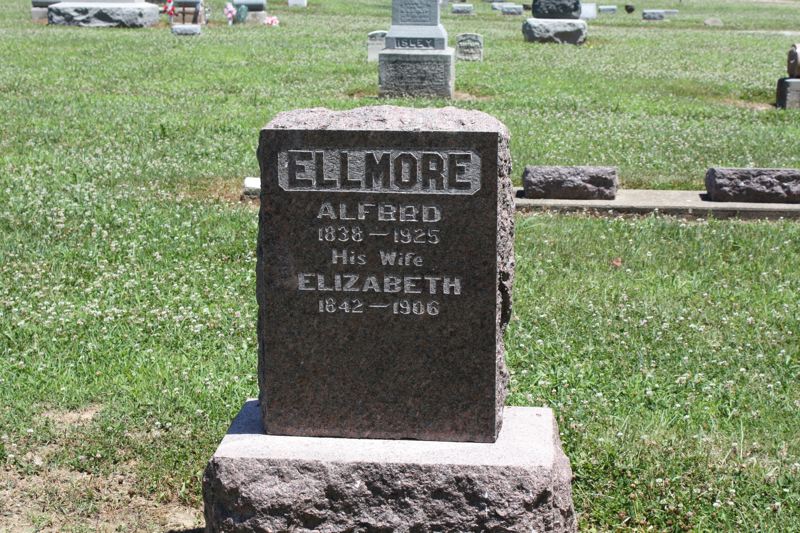
ELLMORE
Alfred
1838-1925
Elizabeth
1842-1906
![]()
Special Thanks
In June, 2009 Tom L. Childers, C. Wayne Kilpatrick and Scott Harp traveled about 3000 miles in one week through parts of Tennessee, Missouri, Illinois, Indiana and Kentucky. During this time we found the graves of 75 church leaders in the Restoration Movement. Chronicling these leaders into websites has been time consuming. Many thanks to Tom and Wayne in helping to take photos, share the driving, and putting up with your web master's slave-driving effort to see as many as we did in the time we had. Their photos as well as some of mine are seen on this site.
![]()
